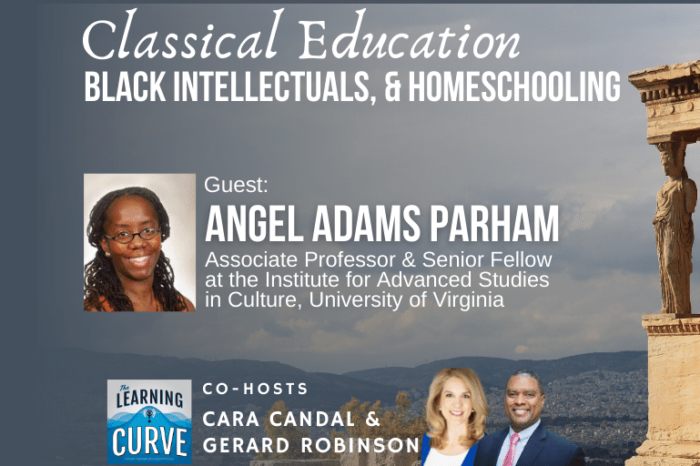UVA’s Prof. Angel Adams Parham on Classical Education, Black Intellectuals, & Homeschooling
/in Academic Standards, Featured, Podcast /by Editorial StaffThis week on “The Learning Curve,” co-hosts Cara Candal and Gerard Robinson talk with Angel Adams Parham, Associate Professor of Sociology and senior fellow at the Institute for Advanced Studies in Culture (IASC) at the University of Virginia, and the author of The Black Intellectual Tradition: Reading Freedom in Classical Literature. Professor Parham shares her background as an academic and former homeschooling mom, her embrace of classical education, and her philosophy about what constitutes a sound humanities curriculum. She reviews the wide variety of ancient and contemporary sources she has drawn upon, and how best to weave both faith and classical learning into the lives of children. She offers thoughts on how parents and teachers should be using enduring ideas of justice, from Plato through MLK, in this time of bitter division, and how to teach about America’s past. They also talk about her 2022 Wall Street Journal op-ed on the importance of classics, and the main themes of her new book.
Stories of the Week: In Maine, multiple police departments have recovered candy-colored fentanyl and methamphetamine in the shape of chewable vitamins, part of a nationwide trend of making these deadly drugs more appealing to younger people. Is the teacher shortage crisis a myth? New research cited in The 74 indicates that teacher turnover rates have not changed since before COVID.
Guest:
 Angel Adams Parham is Associate Professor of Sociology and senior fellow at the Institute for Advanced Studies in Culture (IASC) at the University of Virginia. She is the author of American Routes: Racial Palimpsests and the Transformation of Race (Oxford, 2017), which was co-winner of the Social Science History Association’s Allan Sharlin Memorial book award (2018) and co-winner of the American Sociological Association’s Barrington Moore award in comparative-historical sociology (2018). She also provides resources and training for K-12 educators who are looking to better integrate Black writers and Black history into their teaching. A book related to this work The Black Intellectual Tradition: Reading Freedom in Classical Literature was published in July 2022. She has been a member of the School of Social Science at the Institute for Advanced Study in Princeton, as well as the recipient of a Fulbright grant. She received her bachelor’s degree from Yale University and completed her doctoral work at the University of Wisconsin-Madison.
Angel Adams Parham is Associate Professor of Sociology and senior fellow at the Institute for Advanced Studies in Culture (IASC) at the University of Virginia. She is the author of American Routes: Racial Palimpsests and the Transformation of Race (Oxford, 2017), which was co-winner of the Social Science History Association’s Allan Sharlin Memorial book award (2018) and co-winner of the American Sociological Association’s Barrington Moore award in comparative-historical sociology (2018). She also provides resources and training for K-12 educators who are looking to better integrate Black writers and Black history into their teaching. A book related to this work The Black Intellectual Tradition: Reading Freedom in Classical Literature was published in July 2022. She has been a member of the School of Social Science at the Institute for Advanced Study in Princeton, as well as the recipient of a Fulbright grant. She received her bachelor’s degree from Yale University and completed her doctoral work at the University of Wisconsin-Madison.
The next episode will air on Weds., September 7th, with Timothy Garton Ash, Professor of European Studies in the University of Oxford, Isaiah Berlin Professorial Fellow at St Antony’s College, Oxford, and the author of The Polish Revolution: Solidarity.
Tweet of the Week:
Book banning: NPR reports that at Keller Independent School District outside Fort Worth, Texas, school staff were instructed to remove the Bible from classrooms and libraries. https://t.co/iK5cXFZ4J2
— Education Next (@EducationNext) August 28, 2022
News Links:
Candy colored fentanyl reported in Maine, part of national trend
The ‘Mass Exodus’ of Teachers Never Happened, Paper Argues – The 74 (the74million.org)
Get new episodes of The Learning Curve in your inbox!
Read a Transcript of This Episode
Please excuse typos.
[00:00:00] GR: Hello listeners. This is Gerard Robinson from beautiful and yet rainy Charlottesville, Virginia. As you know, we get together every week, Cara and I, and we bring in some of the top talent in the country, in the areas of education, history, sociology, philosophy, the law, we have advocates, we have CEOs and we have parents and all wrapped in one of course.
[00:00:52] He’s my co-host Cara, how are you?
[00:00:55] Cara: I dunno, I’ve never been a CEO
[00:00:59] GR: but yes. Kara, big CEO of your home. Well,
[00:01:02] Cara: damn straight. Am I allowed to say that on The Learning Curve?
[00:01:06] Cara: that’s right. Gerard. I hope my
[00:01:08] Cara: husband is listening. Actually. He wouldn’t argue with that by any stretch of the imagination. No, I am. I am doing well here in Boston, here in the Northeast, Gerard fun fact, children are not back in school.
[00:01:20] did I say this last
[00:01:21] Cara: week? Am I a broken record?
[00:01:24] Cara: just in case anybody was wondering, I’m still working from home with three kids and you know, what, isn’t open right before Labor Day is summer camp. That’s not happening either. So these are fun times in the Candal household. But at least we’re not in the middle of the pandemic and they.
[00:01:40] They can go and play. Well. I mean, I guess we are, but we’re pretending like we’re not anymore. They can go out and play with their friends and have human contact and stuff like that. So my post traumatic stress is only a little
[00:01:49] bit showing I suppose,
[00:01:52] Cara: but very excited to be back here with you.
[00:01:55] Even more excited than I am for the start of a new school year on September 7th. [00:02:00] Can’t wait for that
[00:02:00] Cara: day.
[00:02:01] GR: Well, here in Charlottesville and Charlottesville is a part of Albemarle county. We started last week, so I see the buses moving in front of the house and children getting on and getting off.
[00:02:15] And so it was good to see bodies back on buses and our two daughters were in school as well. So yeah.
[00:02:21] Terrific. That time of year.
[00:02:22] Cara: What I’m so curious to know when you were a kid, like, what do you remember most profoundly about the first day of every school year? Like what, made you most anxious or excited?
[00:02:33] what was it about for you?
[00:02:35] GR: It was going to school with a new pair of tennis shoes. Yeah. It was just the coolest thing. And of course it’s Los Angeles, so it hardly ever rained. So I didn’t have to worry about that, but it was going to school with a new pair of tennis shoes feeling like I could run faster than I ever could, and then getting together with my friends.
[00:02:52] And we would sit around for lunch like that first week and talk about what we did for the
[00:02:56] GR: summer. Yeah, I
[00:02:58] Cara: think that’s my, own memory too. I would [00:03:00] say like from conscious memory, certainly not when I was like a kindergartner or something, but it all revolved around, like, what was that outfit you were gonna wear on the first day of school, which is kind of sad when you think about it.
[00:03:08] Interestingly, I don’t think any of my children care, they would like wear their pajamas on the first day of school. But I remember it being really big deal and I have a very distinct memory because of course, you know, child of the eighties, do you remember those Coca-Cola t-shirts that were popular for a time?
[00:03:23] Yes. The branded, I have this distinct memory of my like awesome yellow and white Coca-Cola long sleeve polo that I had to beg my parents for because it was expensive. Of course the awesome 1980s hairdo, I had the
[00:03:38] Cara: you know, where the hair
[00:03:41] Cara: took up the whole school picture, like the bangs were cut off.
[00:03:44] So, yeah. Interesting. Those first day of school memories seem so important then, and so far away now, but I’m happy that your girls are back and I hope they’re having a wonderful first week.
[00:03:53] GR: So story of the week , what’s caught your attention.
[00:03:58] Cara: I’m gonna talk about [00:04:00] something that has been catching my attention for a while now, because it’s a little project that I’m working on and just in my, work life and my day life.
[00:04:08] And as you know, Gerard, I was a teacher trainer for many years. So not only did I do teacher training as part of the national academy of advanced teacher education which I was a founding member of back in like 2011, shout out to our friend, Tony Clemmer, who I can call him and tell him to listen.
[00:04:24] But also as a professor at BU of course, part of my job was to people who are going out of, out in the field and be teachers in education policy. And every time I turn on, you know, my part of my morning routine is coffee and morning news and open a newspaper which I still do, or um, listen to my local radio station.
[00:04:45] it’s teacher shortage, teacher shortage, teacher shortage. And I think it’s really easy to get into a space where everybody just thinks, oh my gosh, this is a crisis we’re in the middle of a crisis. But when we really dig into the research, I mean, you and I, I think we’ve talked about this before the sort [00:05:00] of pendulum swing over time, where we go through these periods where it’s like alarm bells are going off.
[00:05:04] There won’t be any more teachers and looking at the research it’s more complex than that. It’s much more complex than saying we have a national teacher shortage. And so all of that said, I really appreciate this article in the 74 by Kevin Mahnken. And it’s called the Mass Exodus of teachers never happened paper argues.
[00:05:25] And so in here, he’s talking about a paper from the Annenberg Institute at brown university, actually written by a former guest on this show, Matt craft, Matthew Craft. And what this is really talking about is, Hey guys, , let’s hold on for a minute and put this teacher shortage in perspective.
[00:05:44] And so the big thing to know here, the headline that I think I hope listeners will understand is that yes, it, between 2020 and 2022, especially right there in the, at the beginning of the pandemic, there was a huge drop in the [00:06:00] number of people who were employed in us K to 12 public education. But what people aren’t talking about is the fact that, that huge drop that precipitous decline in employees didn’t necessarily happen among the ranks of teachers.
[00:06:13] they were more concentrated in school districts, more bureaucratic positions. And then also some very important in school positions like paraprofessionals to some extent, school counselors, but we keep talking in terms of a teacher shortage. And that is not always the case. So what Matthew Craft and his colleague at brown and at Annenberg have done is they’ve taken federal data sets, which are, you know, Gerard you’ve, looked at a lot of federal data sets.
[00:06:40] They’re often old and sometimes difficult to merge and not, and incomplete. Right. but there’s something. And then on top of that, they took statistics from 16 states on teacher turnover. And what these guys come away with is saying, okay, yeah, we have fewer people going into the profession of teaching and that is a problem.
[00:06:59] And [00:07:00] it’s a problem we need to address. And they say but let’s be really clear. Teacher shortages are not. Blanket. They’re not happening across the country everywhere. They’re concentrated as they always have been. Since we’ve been talking about this since I started doing this 20 years ago in certain places.
[00:07:18] So I was reading an article yesterday about Oklahoma city public schools. They now have hundreds of teachers on emergency certifications that if you look at an emergency certification by that, what I mean is people who aren’t actually certified to teach what they’re teaching, but states have to put somebody in front of children, right?
[00:07:33] So they give folks emergency certifications. And then on the other end, you have districts in Oklahoma where there’s only been a request for maybe one emergency certification or no emergency certifications. So by obscuring the. That teacher shortages are concentrated, unfortunately. And not surprisingly they’re often concentrated in highest needs communities.
[00:07:55] So urban centers tend to have shortages more often than suburban districts, right? [00:08:00] And also that they’re concentrated in certain fields. We’ve known for years that we’re not producing enough math teachers. We’re not producing enough stem teachers, people aren’t going in to teach special education English language learners.
[00:08:11] These are the areas in which we’re missing teachers. So why does this matter? This matters because as they argue in this paper, if you don’t understand the nuances of the problem, you’re not going to take the right approach to finding a solution. And so there are two concerns that they elevate here.
[00:08:31] They say, we do need to address teacher pipelines. We need more people going into the professions. Yes, but we also can’t just do it in a blanket way. It’s not about getting bodies in classrooms to be teachers. And secondly, they say burnout is a concern. We need to focus on teacher retention. And this is of course, through Nate, again, shadow to Tony Clemmer.
[00:08:50] Right? What we always worked on at Nate was thinking about how do you keep those high flying teachers, those folks who are the bearers of school culture, those folks who are gonna [00:09:00] mentor the newest teachers when they’re in their first, second, third year of teaching to be great. How do you keep them?
[00:09:06] Because when they. Schools lose a lot. I have certainly worked with schools in my life where, 90%, 95% of the teaching staff in a given year can be all new. And let me tell you that does not work well for academic outcomes. If not, it’s not good for kids. Kids need stability and consistency from the adults in their life.
[00:09:25] And that goes right down to the school level. Many kids are spending more time in school than at home. They want consistent faces. So those are a couple of problems. Now what the authors of this paper don’t talk about are the solutions that they would like to see. But this is something that I know you think about a lot, and I’ve been thinking about a lot and we’ve seen a lot of states come out with grow your own programs, which I think are wonderful approaches.
[00:09:49] It’s identifying kids as early as high school who might wanna become teachers and paying their way through certification bachelor’s degrees. All of these things, many of them are now federally registered [00:10:00] apprenticeships. I think that’s fantastic, but are we really targeting, for example, people who can be math teachers, people who can teach special education that’s one.
[00:10:09] And on the flip side of it, I think we also need to be thinking about what is it gonna take to keep those high flyers in the profession? And by the way, some of those new teachers of today are the high flyers of tomorrow. And so people always say, well, teaching is such an underpaid profession. I’m not gonna disagree.
[00:10:26] Teachers need to make more money, but really interestingly, a lot of data show is when you talk to teacher. They would much rather support in their classroom, in the form of another adult, a paraprofessional, a counselor, than a $5,000 raise, which might barely make an impact on their overall paycheck.
[00:10:43] Right? So we think that there are lots of different ways that we need to be thinking about what so many are. Saying in this very alarming way is the teacher shortage crisis and be more thoughtful, especially those of us who are in a position to influence policies and policy makers be much more [00:11:00] thoughtful about the tools that we use in addressing the current problem.
[00:11:04] And I’ll just end by saying, Gerard, let’s not forget that states are still sitting on a lot of relief, money COVID relief money, and one of the scariest things for my money that’s happening right now. And this is also mentioned in the paper that professor craft authored is that some districts are panicking.
[00:11:23] Maybe they don’t have the right supports and structures and help from the state that they’re in for this. And so they’re panicking and they’re putting COVID relief funds. That might be very well used towards things like tutoring, right? Learning recovery. Personalized attention for kids that you can get, maybe even by contracting out with a known provider.
[00:11:41] And instead they’re hiring for open positions without necessarily considering is this really the position I need? Am I going to fill this position with a qualified person? Who’s going to make a difference. So I think the question for the COVID relief money, especially should be, what’s gonna be the biggest bang for my buck, not just, oh my goodness.
[00:11:59] My budget says I [00:12:00] need 50 people and I only have 47. Really nuance. I appreciate this article. I’m gonna keep watching this theme. It’s something that we’re gonna be talking about for years to come, especially as more and more states, try some great and some not so great approaches to addressing this concentrated teacher shortage and retention problem.
[00:12:18] What do you think
[00:12:20] GR: I’m always glad to hear you talk about your previous lives and what you’ve done, cuz you have such a rich, diverse background, but I particularly enjoy when you talk about your work with teachers, because at the end of the day, that’s where the rubber meets the role. We do policy and we love it.
[00:12:36] And that’s often outside the school building. We can hold rallies and events at schools. Those are outside the classroom, but both inside the classroom and as Julie Young from , our previous shows identified, you can use online learning, but this really matters. And so I’m glad that you brought this up.
[00:12:54] I’m also glad as someone who is a free market or what I call a free enterprise guy is to [00:13:00] understand the role that the private sector can play in this. So when you mentioned stem I immediately thought about 100 K in 10. Talia is the founder and executive director. I believe she’s actually from Massachusetts.
[00:13:12] early on. I had a chance to be an advisor, but they were created to try to create a hundred thousand new stem teachers in 10 years. And they have a boatload of support in the public sector, including colleges of education, but look at the role, the for-profit or the private sector communities playing.
[00:13:31] So when you look at their funders, it’s Chevron Dale it’s Gentech it’s as aspire, of course, it’s Chan Zuckerberg initiative and others, but we’ve gotta get the private sector on board to invest money into making this happen. Because a lot of teachers, when they leave the profession, some of them go and work in the private sector.
[00:13:50] For places like this. Some in fact, actually bypass teaching really wanted to teach, but they’re gonna work for a company. I think one way to build a [00:14:00] bridge is to get private sector companies to actually endow stem chairs in middle school, in high school. So if it’s the Chevron share, it’s the Dale chair.
[00:14:10] You fund that chair, pay the teacher on interest only. You don’t touch the principal during the summer, have the teacher actually come to work for Chevron or Dale or another company pay that teacher the same salary he or she would’ve made. Have they been a full-time employee with the goal of taking the information back to the classroom, maybe writing a paper that they can use to share with others, but giving money is one way, but I don’t think we’re gonna solve the stem teacher problem until we do what we do in higher ed, which is endowed chairs in stem.
[00:14:42] We’ve gotta do it in middle and high school. So just
[00:14:45] my two cents.
[00:14:46] Cara: Gerard, I just gonna say my friend, I love that. And after the show, we’re gonna hang on the line and you and I are gonna try and talk about how to make that into policy that states will actually adopt. So
[00:14:55] thank you for that. Ah,
[00:14:57] GR: we’re gonna do that.
[00:14:58] And listeners, you heard it right [00:15:00] here. On the learning curve. Promise my story. Yeah. Well, my story isn’t as exciting, but it’s equally as real. And as we talk about, you know, the 50 million plus students returning to public schools, the over 7 million going to private schools, many more students who are now homeschooling.
[00:15:19] One thing we have to remember is the fact that some of our children are finding themselves targeted for drug use. And so my story is from the spectrum, which is a local outlet in Maine. And the title of the article is. Candy colored fentanyl reported in Maine part of a national trend and the authors are Elizabeth Barmeyer and Susan cover, and they identify that two police departments in Maine, one in Bangor, and one in Farmington have reported the seizure of candy colored, fentanyl and meth.
[00:15:55] And it’s part of a trend, not only in Maine, but the national level, but let’s [00:16:00] just focus on Maine right now. When the police sees the candy colored, fentanyl and meth, they actually share the information with Maine’s information and analysis center. And it’s actually an intelligence gathering service that shares information between states and the federal government.
[00:16:17] Now, Ken Charles, who is the chief of police in Farmington, he said that drugs returned over to the police by a family member of someone who was actually seeking. No charges were filed and the police believed that the drugs were in fact meth. In addition to coming in different colors, get this. The meth as well as incoming fentanyl is shaped like dominoes.
[00:16:42] One piece of meth that I happen to see in the article had a rose Royce hood ornament on it. Oh, they were also face of other people and they come in colors. I mean, you could think it was a box of lucky chars when I was a kid. And so what chief Charles said is [00:17:00] that these drugs resemble vitamin. And they’re chewable for children to quote him.
[00:17:07] He said, if they were mixing a bottle, you would think you were eating or had Flintstone chewables. And it’s very unsafe now for some of our listeners who may be familiar with this either from personal professional experience. But for those who aren’t, fentanyl is a powerful synthetic opioid. And it’s been linked to approximately 75% of the drug overdose deaths in the first six months of 2022 in Maine, according to the office of the attorney general, approximately 266, people have died in the state a year ago, 636 people died of a drug or ADOS in Maine, which set a record.
[00:17:47] That’s just not adults, but it’s also children. But this is not just a main problem. Let’s look at a national trim. There’s someone named Andre Swanson, who is a public information officer with the drug enforcement administration in [00:18:00] St. Louis. And he told spectral news during the interview that when you color fentanyl, it’s just another wave of appealing to youth.
[00:18:08] And here’s a quote, drug traffickers will do anything to increase their profits, adding a trendy candy color to the drug. Will lead to more deaths and also way of making more money. Swanson went a step further to say that when we talk about fentanyl, we have to put it in contact with other drugs.
[00:18:27] Swanson said, fentanyl is quote 100 times more dangerous than morphine and 50 times more potent than heroin. Sometimes people think they’re actually taking one type of pill when it’s actually fentanyl. If we go to the Western states in Arizona, get this us custom and border protection officers sees more than 15,000 colored fentanyl pills recently.
[00:18:53] And they were actually strapped to someone’s. Right now nationally, approximately a hundred thousand people [00:19:00] overdose every year. But what does this mean for young people? So earlier this year, the journal the American medical association known as Jamma released a study about drug deaths among adolescents and Joseph Friedman, who was a uh, UCLA addiction researcher and the lead author in the Java paper.
[00:19:17] He said drug use is becoming more dangerous, not more common. So initially when I was studying for our conversation today, I was just assuming that more drug use was in place. This author and others actually identified that drug use amongst teams has gone on somewhat over the past 10 years.
[00:19:36] And some areas actually flattened. And in some areas it’s gone down. So it’s not drug use instead. What Friedman is saying, he said to some degree, I think that is just a national progression of the fentanyl crisis in general. And what does he mean by that? Well, number one, he identified that the type of fentanyl that students are using or getting to hold to right now, more powerful and more dangerous than before, [00:20:00] but he’s also seen a trend over the last couple of years with the number of young people dying from fentanyl.
[00:20:06] So according to the paper, 512 adolescents died of an overdose in 2010, that was roughly 2.4 people for every 1000 individuals in 2019, the rate did not change much 492 deaths or two point three six people per 1000, but get this in 2000, the number jumped to 954 adolescent overdose deaths.
[00:20:33] And in the first six months of 2021, it actually increased 20%. Up to 5.4 per 1000. So naturally we have to ask the question. Why was there such a major increase over the last two years where between 2010 and 2019, it remained rarely flat. Now I’m saying that for statistical reasons and in no way, am I trying to gloss over the fact that [00:21:00] 518 adolescents died in 2010 and 492 in 2019, but why?
[00:21:06] Well, naturally I would say COVID and there’s one researcher, Scott Holland who’s uh, chief of adolescent and young adult medicine at Massachusetts general hospital. And you’re a neck of the woods. Scott actually said that mental. Worsen during the pandemic and that for many people, the two go hand in hand.
[00:21:26] So some young people who in fact had mental health issues also find themselves reaching out for drugs to address it and getting a hold to some bad drugs. So that’s one aspect. Scott also said the pandemic also interrupted treatment programs for adolescents who were dealing with drug use. So that’s one, but why 2020?
[00:21:46] Well COVID is a factor. But the research has also said, let’s remember that the type of fentanyl that young people are absorbing in their body right now is more dangerous in 2020 than before. And experts say that [00:22:00] we have to take a look at that. So when I hear those, stats, I think, you know, where do we go from here?
[00:22:05] So here are three recommendations. The scholars recommend. And of course as always you’ll have access to those articles in our webpage, number one, talk to children about drugs and particularly young children who will see a drug and think that it’s candy. I know how that works. Personally, when I was four or five years old, I found myself rushed to a hospital in Los Angeles to have my stomach pumped because I had overdosed on pills that my mother was taking.
[00:22:32] They were diet pills and they were red and he smelled like strawberry. So I thought it was strawberry candy. And I literally poured like 25 in my hand. And took the ball at once, started vomiting. Luckily parents were there and I was taken to the hospital. To this day, I still have a physical reaction when I smell strawberry flavored candy.
[00:22:51] So I know how that works. Number two, work with local drug prevention and treatment programs in your area. Many of them [00:23:00] have people who understand what to do, and if you’re a family in need or an educator in go there I’ll also say you’ve gotta work with the local police. It was police departments in Bangor and Farmington, also in other cities that are trying to bust some of the drug rings.
[00:23:15] And while I understand there’s still some who say we should defund the police on one end. And while I also understand the code or the streets where we say snitches, get stitches. Through police have a role to play in this. And lastly, and this is something that was interesting right now, according to one federal report, all 50 states have a good Samaritan law and a good Samaritan law will allow someone like Kara.
[00:23:37] I to see someone in distress to provide him her support, to try to help them, revive them, to help them. And just in case the person is injured or dies while we’re trying to do. We’re not held criminally responsible for that. Someone said, why don’t we make good Severan laws available to teams who may find themselves in a similar situation where someone who overdosed.
[00:23:59] So [00:24:00] that’s my story of the week. I have spent a lot of time working with people as you know, who are incarcerated. Many of them are in prison because of drug use because of drug distribution. Many of them will tell you that meth and fentanyl destroyed their lives. It has taken a particular hit in places like Massachusetts, Ohio, Maine, Louisiana, and Florida.
[00:24:21] And it’s really hitting rural communities, particularly poor white families. So in our broader conversation of what to do about American fabric, this has to be a part of the convers. What are your thoughts? Oh my
[00:24:32] Cara: gosh, my thoughts. I’m gonna go and hug my children really tightly and continue to talk to them all the time about these issues, even when they’re really little, because I, I am a hundred percent with you.
[00:24:41] I think having real honest conversations with your kids from a young age about the consequences, because you know the thing that scares me well, there’s so, so many things that are scary about this, but especially when you’re talking about kids, we know developmentally not only are they not able to make adult decisions, not that adults don’t always make decisions, but that [00:25:00] their impulse control is almost non-existent even for many children, , who don’t even look like children anymore up into our twenties.
[00:25:06] We’re not fully developed. And if you don’t get a chance to make a mistake by saying, I’m, depressed or I’m in a bad place, and I’m gonna take this drug. And the drug is so powerful that it’s it’s one and you’re done. it’s just too much of a risk. It’s not like it was Gerard, I think when you and I were growing up and.
[00:25:23] Nancy Reagan could tell us to say no to drugs, but we weren’t talking about drugs for the most part that were going to kill us the first time. Thank you for sharing your story. That’s I can only imagine how frightened your parents must have been. And, we do have to introduce our guests, but there’s one more thing I would add.
[00:25:38] And that is the burden on schools. When really, sick people are trying to make these things attractive to children. this just one more thing? It is one more thing that schools have to worry about and it’s if kids are passing around something which looks like candy , you’re not
[00:25:56] smoking
[00:25:57] Cara: or, doing, you know, passing around a [00:26:00] powder or something that an adult would recognize as a drug it’s like technology.
[00:26:03] It, it is technology. It’s always one step ahead of us. And this is a really scary, scary story. thank you for. Depriving me of sleep tonight, Gerard but I do think it’s an important story and I’m glad you brought it to our attention. we’re gonna take a hard left here and we’re gonna bring in actually a friend of yours.
[00:26:22] We are gonna be speaking with Professor Angel Adams Parham, Associate Professor of sociology and senior fellow at the Institute for Advanced Studies in Culture. So we’ll be back right after this.[00:27:00]
[00:27:12] Cara: Welcome back
[00:27:13] Cara: Learning Curve listeners. We are here with Angel Adams Parham, associate, professor of sociology and senior fellow at the Institute for Advanced Studies in Culture at the University of Virginia, where she gets to work with my favorite co-host, the great Gerard Robinson. She is author of American Routes: Racial Palimpsests and the Transformation of Race [00:27:30], which was co-winner of the social science history. Association’s Alan Charlon Memorial book award, and co-winner of the American sociological Association’s Barrington Moore award in comparative historical sociology. She also provides resources and training for K to 12 educators who are looking to better integrate black writers and black history into their teaching.
[00:27:52] A book related to this work, The Black Intellectual Tradition: Reading Freedom in Classical Literature was published in July 2022. She [00:28:00] has been a member of the school of social science at the Institute for advanced study in Princeton, as well as the recipient of a Fulbright grant. She received her bachelor’s degree from Yale university and completed her doctoral work at the university of Wisconsin, Madison, such a beautiful place.
[00:28:14] University of Wisconsin, Madison. My husband’s a Yale man. He might push back on me for giving Madison a shout out, but at any rate, welcome to the show Dr. Parham
[00:28:22] Angel: Thank you so much. It’s a pleasure to be here.
[00:28:27] Cara: We are really excited to have you. I mean, what, a bio and something left out of the bio is that I, and this just, I is, I’m always so blown away.
[00:28:36] You’re not only an accomplished academic. You are also a homeschooling mom. So tell us about yourself. I wanna know how you became interested, not only in your work, but also what, led you to become a homeschooling?
[00:28:51] Angel: Absolutely. Yes, it’s, it’s a rather interesting story, as you might imagine. I homeschooled my daughters and I’ve done it [00:29:00] in various ways from when the oldest was two years old, all the way up through the end of ninth grade for her.
[00:29:08] And then my youngest as well through the end of sixth grade, since we’ve moved to Virginia, they are now at a classical school, which continues the whole philosophy of what I was doing at home. So we’re in a, a different phase of our education now. But what brought me to it it’s very interesting.
[00:29:27] So I was on sabbatical for a year, as you said in the bio. And we were away from home and the kids were very young. So the oldest at that time was five and the youngest was two. And so rather than put them in a school for one year and then yank them out and move back home. I had already been thinking positively about homeschooling and thinking.
[00:29:49] I might be able to manage it. With my teaching schedule. And so we just went for it. at five and two, we had our little table and we had wonderful literature that I would [00:30:00] immerse them in. And we started there and I loved it so much and we just continued doing that from then on. So that is where I started did that for 11 years where I was fully homeschooling them.
[00:30:15] And it was just a pleasure. It was also, you know, as you might imagine, challenging to manage working full time and homeschooling, but it was just such a privilege and it opened up whole worlds for me including introducing me to classical educat.
[00:30:32] Cara: tell us a little bit more about that. Tell us what classical education, , what role it played.
[00:30:37] You said it introduced you to classical education, but why was it so important to you and why is it continue to be such an important part of the education
[00:30:44] Angel: you want for your children? there are a couple different ways to get into it. One way that classical educators speak of is educating for truth, goodness and beauty.
[00:30:54] With an emphasis on great books and great text. And so [00:31:00] that in and of itself, is just a very attractive vision. I had not grown up with this idea of education as truth, goodness, and beauty. And while I read some good books, I wasn’t necessarily exposed to very many classics.
[00:31:14] So I was actually introduced to classical education by another black homeschooling mother who was a leader in classical conversations, which I took part in. So that’s a, homeschooling organization. And when I went um, I went for an open house and the kids were singing the timeline song, which is this wonderful 12 minute song where the children sing from, early history from the beginning of the world, up until the present.
[00:31:41] And it’s one of the most impressive things that you can ever behold young children, as young as. Four years old. We’ll sing this timeline song and there are a number of resources that go along with it where you can dive into different aspects of the history from ancient history up to the present.
[00:31:58] I just found it such a beautiful, [00:32:00] orderly way , of organizing education. And then I would get to learn things like Homer’s Odyssey. So we got a children’s version of the Odyssey and that was my first time reading the Odyssey. And I just started to think why haven’t these texts been part of my life?
[00:32:17] So the more I was schooling the girls, the more I was getting my own classical education, and that’s not unusual amongst some classical homeschoolers. Most of us did not have a classical educat. And so when we then educate our own kids, we get to kind of reclaim our own education and learn alongside with the children.
[00:32:39] And so that really just influenced pretty much every aspect of my life. It led to I and my friend who introduced me to classical homeschooling to us founding the nonprofit YSA classical community, which brings classical education to low income students of [00:33:00] color. And so have been doing that.
[00:33:02] This is our seventh year doing that work, which has been incredibly fulfilling. And then also reading these classic texts has begun to inform my own scholarship at the university. it’s just been a wonderful discovery for. That’s amazing
[00:33:17] Cara: as, the mother of young children. Well, my oldest will be headed to seventh grade this year, which is very, very exciting.
[00:33:24] I think we’ve dabbled a little bit and tried to read some children’s versions of those classics, but you inspire me. I think that is pretty, pretty neat that especially the idea that you’re learning right alongside them. I can remember reading some classic text Israelis high school, but certainly not at elementary school age.
[00:33:41] could we expand a little bit here? I would love for you to tell our listeners a bit more about this shared lessons about vice and virtue and human nature that you think should be embodied , in the kind of sound classical curriculum, humanities curriculum that you are teaching at home, and that your
[00:33:57] Angel: children will continue to experience.
[00:33:59] [00:34:00] Sure. So yes, we read classic texts and we also read a number of founding American documents as well as we are doing that kind of education. And it’s really just replete with these lessons about vice and virtue. Um, That’s another aspect of classical education is it’s very much focused on the idea of cultivating virtue and, really trying to help our children to learn these lessons from the past.
[00:34:27] And so some examples of that. looking at the constitution, for instance, one of the, main founding documents as I was doing some of my own background research on this, I also do some training with some classical educators and I was doing some background research for lecture material for.
[00:34:45] And what was really fascinating for me was looking at James Madison’s notes on the constitutional convention where you see how all of these compromises played out behind the scenes. You know, we have the final [00:35:00] version of the constitution, but in those notes that Madison has, you really see the back and forth over the controversial issues.
[00:35:07] Like the three fifth clause. For example, the electoral college is another example. And you see where the north and the south are really trying to figure out how to work together and move forward with this issue of slavery always looming in the background, this connects to the work of Frederick Douglas.
[00:35:25] Who’s another one who’s a very key writer that I love to teach. So Douglas made this life changing decision. He had initially felt along with many other abolitionists that the constitution enshrined. Slavery and was really oriented toward keeping African Americans enslave. But as a result of several conversations he had over the course of time, he came to believe that instead the constitution really sewed the seeds of freedom.
[00:35:58] And so he [00:36:00] really studied that text very, very carefully and could see where there were so many opportunities there for African Americans to fight for their freedom, , similar to the way that Martin Luther king Jr. Talked about the promises of the American revolution, being this kind of promissory note of freedom, the declaration in the constitution that maybe we did not get those rights at that time as African Americans.
[00:36:25] But that was a promissory note that was going to be delivered to us that we would claim. And so Douglas, I think is one of the first of, , the wonderful black intellectuals who wrote very much on this and who provides, I think an example. Where instead of being polarized one side or the other, on the idea is the American project, , fundamentally flawed, is it fundamentally something that leads us to freedom?
[00:36:53] Douglas has this really nuanced way of thinking that helps us to work through that. And by [00:37:00] going to the original debates in Madison, you also get that behind the scenes look at how, , you use the democratic process to try to weigh vison virtue.
[00:37:11] GR: So professor, so that’s actually a good segue to my first question.
[00:37:16] So right now we’re living in educating young people all across the country in a bitter time in American history where we have divisions based upon race class and gender you’ve said before, and I quote, everyone wants to be on the side of what they see justice to be. End of quote. Could you talk to us about how.
[00:37:35] Our parents and teachers, just educators in general should be using enduring ideas of justice, whether they’re drawn from Plato, Aristotle, you mentioned Douglas, but we can also add in Dubois MLK and some of the women who you studied as well. What are your thoughts?
[00:37:51] Angel: Certainly, yes. Justice is very much on the agenda right now, and everyone is convinced that they are on the right side of it.
[00:37:58] And so here’s [00:38:00] where I, I also do think that going back to these classic texts and, learning some history is, very helpful. one of the things that I’ve really like to do is to put these different texts into dialogue that is texts from the black intellectual tradition and then texts that have long been considered to be at the center of the cannon.
[00:38:18] So an example here would be. the horrible death of Michael Brown, which has been very, very controversial. People have come down on different sides there. there is a play by philosophically called anti that in some ways, raises very, very similar issues in anti anti’s.
[00:38:39] Brother is part of a war that was also very, very much contested. It wasn’t clear that he was on the right side of it, but whatever the situation was, he was killed. His body was left in the street and it was ordered that no one could bury it. And anti defies this order, she says there [00:39:00] is a law that is higher than the law that humans make.
[00:39:04] And I have to go, according to that law, there is a group called theater of war. That uses theater for healing. And they went to Ferguson to do anti in Ferguson, and they brought people together in that community across lines of race, across different socioeconomic backgrounds to redo this play anti in Ferguson and to help people to work through all of the difficulties of the injustice you know, the racial tensions.
[00:39:38] And it became this way of using this ancient text to speak to contemporary issues of justice and race in America. And there are other kinds of pairings that I’ve also explored. So MLK who also brought up Martin Luther king Jr. I like to read his letter from a [00:40:00] Birmingham jail together with sections from Plato’s apology, because king cites Plato in that talk.
[00:40:07] And one of the things that you see there is that king is drawing on this image of the gadfly. So the gadfly, which sings an animal and, you know, it’s basically a pain in a butt, but what Socrates says in the apology, and then what king is also saying in his speech is that every society needs a gadfly to spur them to do what is right.
[00:40:32] So when we are apt to become complacent, it is that gadfly who we don’t always wanna hear from it’s that gadfly who keeps us on the right way and who keeps us intention to really examine what we’re doing and to interrogate our actions.
[00:40:49] GR: Absolutely. Well, let’s shift to another topic. So in our current public debate about who’s right, who’s wrong.
[00:40:58] On one side, you have the [00:41:00] 16, 19 project, which has received a lot of praise as well as criticism. And in part, as a response to it, you have 1776 unites, equally heaped with praise and criticism. And they’re both talking about the American past and what it looks like and what it means. And so what would you say to parents and teachers alike about how to navigate this difficult L gate so that students can have a balance understanding of America’s meaning virtues and successes, as well as dealing with some of its grade deficiencies and failures in order to hold up bigger ideas about civic values.
[00:41:38] Angel: This has been one of the things that has been one of my greatest motivations in the work I’ve been doing recently. With students and teachers, because I fear that we are just becoming more and more polarized along these lines. Exactly what you said, 16, 19 versus 1776. And , it shouldn’t be one versus the other.
[00:41:57] They’re both significant parts of our [00:42:00] history. So what I recommend and what I do is to focus really as much as possible on. Founding documents on primary sources so that what you’re wanting to do is to bring students to as close as possible to those original voices. I try very much not to bring my own agenda to it.
[00:42:26] It’s not to say that I don’t have a, point of view, but when dealing with students, what I want them to do is I want them to come to those documents to look at the declaration, to look at the constitution, but also to read things like significant Supreme court decisions, like the Dr. Scott decision, for instance, to read Frederick Douglas Douglas has a very moving speech about the Dr.
[00:42:50] Scott decision. He’s got a wonderful talk about Lincoln, where when he’s talking about Lincoln, it is. For the dedication [00:43:00] of a statue, the Friedman’s Memorial to Lincoln, but he actually starts out being critical of Lincoln and saying, you know, it took him a while to kind of get together with emancipation, but he finally came to it.
[00:43:12] Douglas is a great model of being able to look at where are the flaws, but also being able to celebrate the successes. And so I think looking at founding documents and primary sources as much as possible, looking at the work of great speakers and writers like Dubois and Douglas is also very important.
[00:43:34] Phyllis Wheatley is one who is often overlooked, but she was there at the beginning with the revolution, very supportive of the American revolution, but also very critical of American racism. So I think many of these writers are wonderful guides to being able to call out what is wrong and also celebrate what is right.
[00:43:56] GR: When I think about wonderful articles that [00:44:00] make me think a lot. I think about your May, 2022 article on the wall street journal. And in there you said excellence and diversity can coexist with an education in the classics. The classics should be evaluated and broadened diversify through context and accumulated knowledge.
[00:44:17] I am an alum of Howard university. I studied philosophy while I was there. I had friends who also studied the classics. In fact, our First woman at Howard to earn a Rhode scholarship was a classics major. And at the time I was there, Frank Snow was still on the staff and we had some other classes as well.
[00:44:37] What I heard then, and that was in the 1980s. Why do black people in particular wanna study philosophy or the classics and then number two today you have, why would anyone black, white, Asian, Hispanic, or otherwise one is study classics. Would you elaborate on your article in the wall street journal and then talk to us about the main themes from your new book, the black intellectual [00:45:00] tradition, reading freedom and classical literature.
[00:45:03] Angel: Yes, you’re right. So it used to be why would black people want to study the classics? And that’s still a question, but it’s also become, why would anyone want to study the classics? And I think the answer is that. We are a relatively young country. We are so forward looking that often the past and the wisdom of the past gets overlooked.
[00:45:29] And so I think we have to be very conscious to look to the lessons of the past, to look to great writings in order to give us guidance for how to move forward. For instance. So often the kinds of controversies that we’re caught up in these are conversations and issues that have. Occupied others at other times and other places.
[00:45:53] And we can learn from that by reading classic texts, they can help us to really reflect [00:46:00] on this. So for example, what I was saying about antigay and then antigay and Ferguson. it’s not the case. That’s studying that text and, coming together in community around it is going to fix our injustices, but it gives us some perspective.
[00:46:15] It gives us some larger issues of, justice and ethics to think through. It provides a framework for our conversation, rather than us just dealing at the superficial level of what we have today. It provides cultural and historical resources, and that’s why I’m so passionate about it. Anyone in order to move forward?
[00:46:37] Well, you need really good historical content, cultural content that you are drawing from in order to come to your conclusions about how to live well and how to deal with various controversies that we are going through. So in terms of the book My co-author and I, Dr. Nika Prather wrote the book [00:47:00] because we are both very devoted to the classics.
[00:47:03] And we’re both devoted to this understanding of the classics that it embraces people of all different cultures and backgrounds. And so one of the ways of thinking about classical education is that it invites students to be part of a larger conversation, organized around questions. Like, what is justice?
[00:47:24] What is goodness, what is freedom? What does it mean to be human? These kinds of questions that have been Part of the discussion going back for millennia. And so we wanna invite our young people to that conversation and help them to know that they have a place in it. So what the book does is to also show how black intellectuals have long been part of that conversation, because that’s a part of our history that has been forgotten.
[00:47:53] So we wrote it for that reason, but we also wrote it to make the case , and we think, and hope it’s a [00:48:00] compelling case that it’s also important for majority students of European background to be reading these black writers as well. For example, the question what is the essence of freedom? a very key question, certainly for us as Americans and a very key question going back for millennia.
[00:48:22] So who better to speak to that kind of question of what is the essence of freedom. Then a people who have had to overcome great injustices who have had to overcome a background of enslavement people like Phillis Wheatley, like Olauda Equiano who was also kidnapped from west Africa and wrote his story like Frederick Douglas, like Dubois are able to speak to these great questions.
[00:48:48] What does it mean to be human? What is the essence of freedom in ways that you’re not going to get from anyone else? And so for those who are really committed to [00:49:00] wrestling with these great questions, it’s imperative that they be reading black writers, particularly in a context like the United States. So we wanted the book to speak both to the black community to say, this is already part of your heritage.
[00:49:13] Well into the end of the 19th century black students were being trained in the classics. And then we also wanted to speak to the majority population to say, there are also really important reasons that you should be reading these excellent black writers.
[00:49:30] GR: When you mentioned Dr. Martin Luther King, of course we know him as a preacher or even a pastor, but we often fail to realize that he initially did not want to become a pastor.
[00:49:42] He had come from a generation of pastors and he believed there was too much emotionalism alone until he had an opportunity to hear from Dr. Benjamin E. Mays. Who’s famed for a number of things, want to be in the president of Morehouse college. But Dr. King said he became a [00:50:00] spiritual father for me because he took intell.
[00:50:03] Religion, social science to humanities and blended it into a way to articulate the human condition. He studied rhetoric. He earned a PhD from the university of Chicago. And so the importance of a teacher flipping someone who loved the classics, who loved religion, who loved literature to help bring Dr.
[00:50:23] Martin the king in there. So I want to give a shout out for Dr. Mays as well, and the importance , of teachers and mentors. We wanna close by giving you an opportunity to read a passage from the book you just described.
[00:50:35] Angel: Certainly, and thank you for that opportunity. So I’ll be reading from our first chapter, many writers within the black intellectual tradition, take us through the darkest chapters of our history, calling us not only to look and see, but to feel and grieve with them.
[00:50:53] And yet they do not abandon us to grieve the writers. We will examine in this book. We’re also people of [00:51:00] faith. Their lives are models for how it is possible to live through egregious and justice and sorrow in a way that allows one to be whole in spirit and to work toward a world more rather than less filled with truth, goodness and beauty.
[00:51:15] It is in this sense that even as they usher us through the valley of lamentation, showing us with their lives, how to endure unjust trials, they hold onto hope and as issue, prolonged anger and bitterness, because they are secure in the knowledge that God is on the side of justice. They not only grieve, but they also help us to see through the darkness toward the light.
[00:51:37] This is
[00:51:38] Cara: absolutely beautiful professor angel Adams per thank you so much for this time today. I know I have personally learned a lot from listening to you, what an amazing human being you are. And it sounds like your daughters are very fortunate. I think you said daughters ,
[00:51:53] your children are very fortunate
[00:51:56] Cara: to have had you as an educator and of other, and we’re [00:52:00] fortunate to have had you on the show today.
[00:52:01] Thank you so much.
[00:52:03] Angel: Thank you so much. I really appreciate it.[00:53:00] [00:54:00]
[00:54:15] GR: So my Tweet the week comes from EducationNext, August 28th. And here’s what it says. Book banning national public radio reports that a Keller independent school district located outside of fourth work. Texas has asked school staff to remove the Bible from classrooms and libraries. So at a point in American history history where we’re having conversations about critical race theory and questioning books like woke baby and other points, we are also forgetting that there is another cultural war taking place as well.
[00:54:47] And this one has to do with the Bible and whether it should be in the classroom or. My goodness, there has been state and federal Supreme court decisions about this for a long time. There are also non-profit organizations which have worked with local [00:55:00] school districts or individual schools to show how the Bible can either a be taught as a part of literature or B find itself as part of a broader book level conversation in afterschool programs.
[00:55:12] But that is the tweet of the week.
[00:55:16] Cara: Gerard people need to chill out. moderate yourselves, people on both sides on both sides, moderate. Yes, of course. The Bible can be read as literature in the greatest literature, in any language. and we should also be able to let kids read literature.
[00:55:33] That’s going to provoke conversation, including quote unquote, woke literature. As I said, at the outset of the show, Gerard America, the country that loves to ban a book. My goodness gracious. Okay. we’re gonna be back. I’m sure there’ll be more talk about how bananas we’ve gotten on both sides of the political spectrum.
[00:55:51] Next week, we’re going to be talking with somebody who I’m sure is not bananas. We’re going to be speaking with Timothy Garton Ash. He’s professor of European [00:56:00] studies in the university of Oxford Isaiah Berlin, professorial fellow at St. Antony’s college, Oxford and author of the Polish revolution, solidarity as somebody who spent a lot of time in Poland and is very fascinated by the Polish revolution.
[00:56:15] I’m eager to catch up. So until next week, Gerard, please take good care.
[00:56:21] GR: I will do so. Take care.[00:57:00] [00:58:00]
Recent Episodes
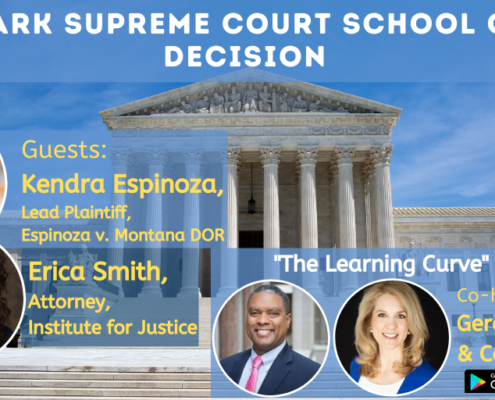
Lead Plaintiff Kendra Espinoza & IJ’s Attorney Erica Smith on Landmark SCOTUS School Choice Decision
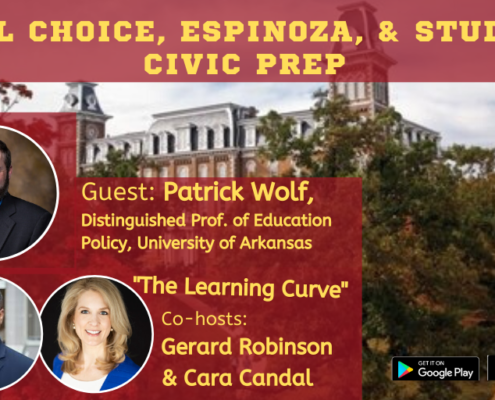
U-Arkansas Prof. Patrick Wolf on School Choice, Espinoza, & Students’ Civic Prep
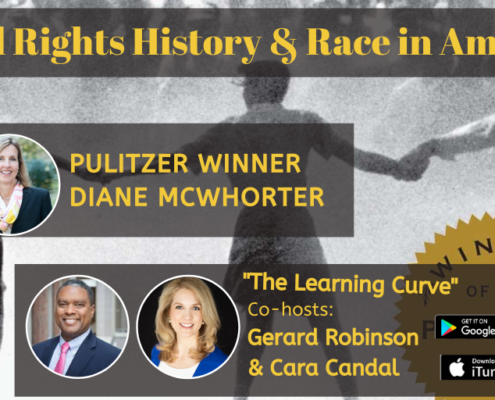
Pulitzer Winner Diane McWhorter on Civil Rights History & Race in America
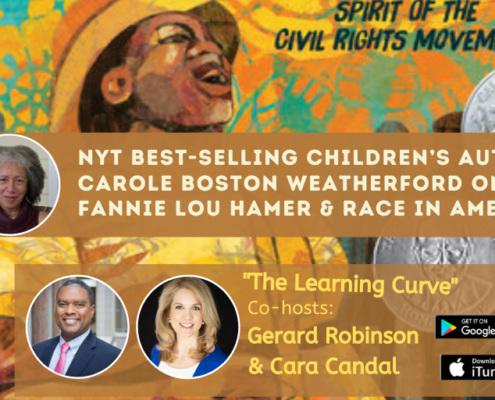
NYT Best-Selling Children’s Author Carole Boston Weatherford on Fannie Lou Hamer & Race in America
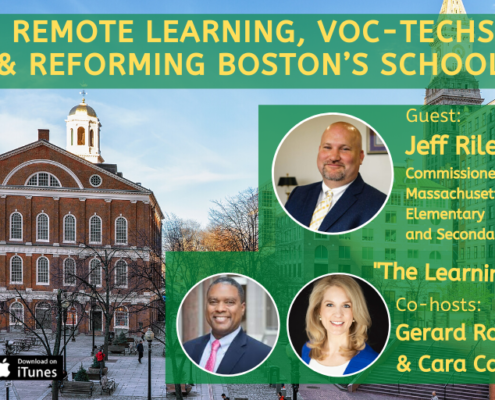
MA Commissioner Jeff Riley on Remote Learning, Voc-Techs, & Reforming Boston’s Schools
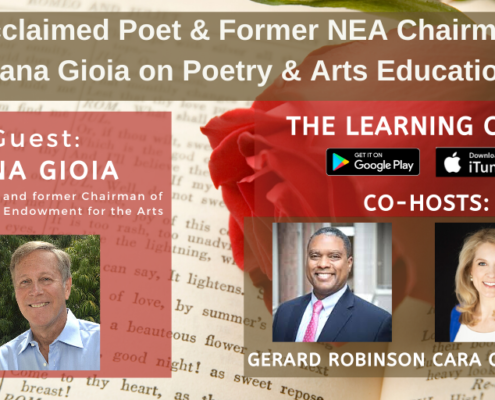
Acclaimed Poet & Former NEA Chairman Dana Gioia on Poetry & Arts Education
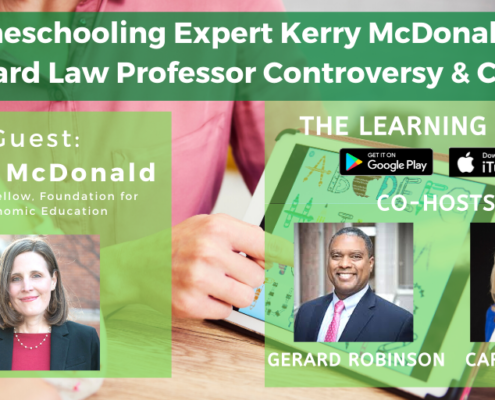
Homeschooling Expert Kerry McDonald on Harvard Law Professor Controversy & COVID
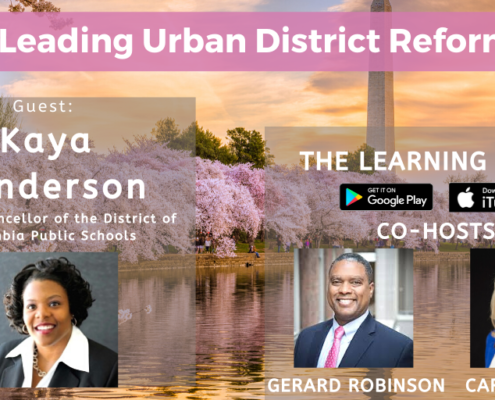
Kaya Henderson, Former Chancellor, D.C. Public Schools, on Leading Urban District Reform
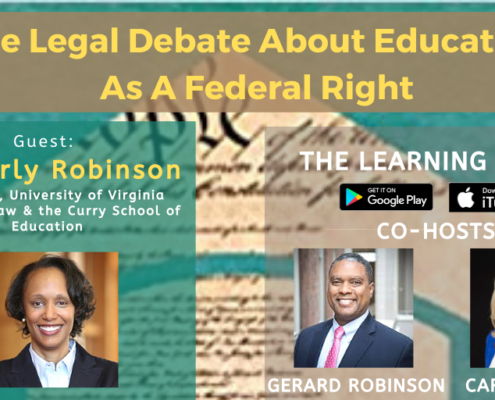
UVA Law Professor Kimberly Robinson On Legal Debate About Education As Federal Right
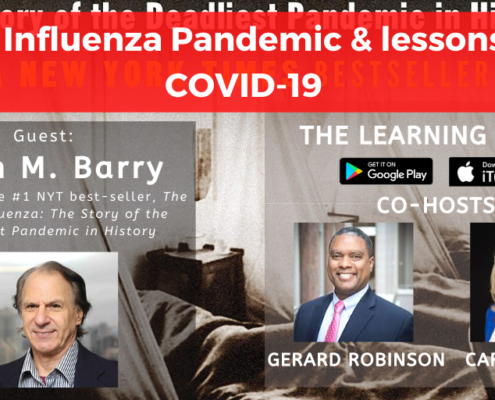
New York Times #1 best-selling author John M. Barry on the 1918 Influenza Pandemic & lessons for COVID-19
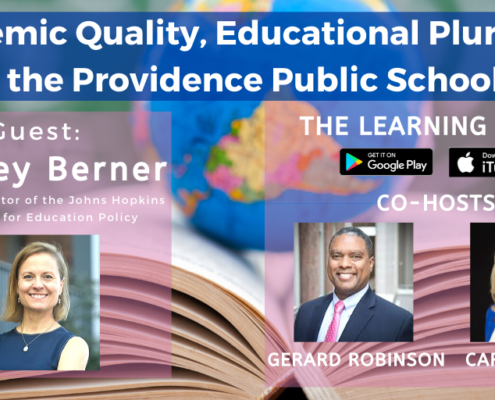
Ashley Berner of Johns Hopkins on Academic Quality, Educational Pluralism, & the Providence Public Schools
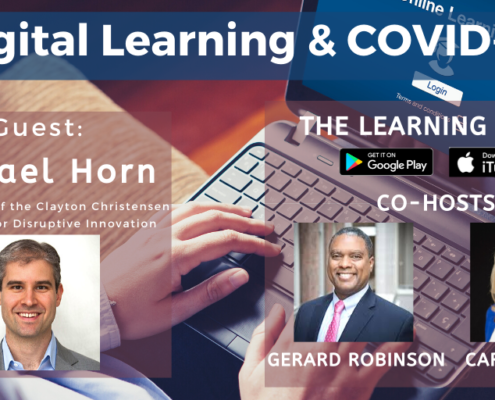
Christensen Institute Co-founder Michael Horn on Digital Learning & COVID-19

